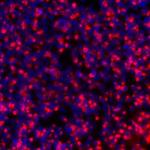
Michael E. Ward, Ph.D.
Senior Investigator
Inherited Neurodegenerative Diseases Section, Neurogenetics Branch (NGB)
NINDS
Research Topics
Our research focuses on cellular and molecular mechanisms of frontotemporal dementia (FTD) and Amyotrophic Lateral Sclerosis (ALS), two related neurodegenerative disorders. We use a combination of cell biology, proteomic, and functional genomic approaches in iPSC neuron models of ALS/FTD, with a long-term goal of understanding how disease-associated familial mutations lead to neurodegeneration. Our group has made several major contributions to the field over the past several years: 1) New tools that enable large-scale production of human iPSC-derived neurons and genome-wide CRISPRi screens, and conception and management of a large-scale genome engineering iPSC initiative (iNDI). 2) Discovery of a new mechanism of axonal RNA transport in neurons that involves lysosomal hitchhiking, a process that goes awry in familial ALS. 3) Characterization of dysregulated splicing in ALS/FTD due to mislocalization of TDP-43, uncovering novel disease-relevant splicing targets and potential biomarkers. 4) Discovery of widespread DNA break/repair events at neuronal enhancers that are likely necessary for epigenetic regulation. Each of these efforts have been highly collaborative in nature, involving multiple teams from independent institutions.
Neurodegenerative diseases are common, debilitating, and often untreatable. We believe that a better understanding of the basic biology of these diseases will serve as a foundation upon which to develop effective therapies. Our group focuses on two related neurodegenerative diseases, frontotemporal dementia (FTD) and amyotrophic lateral sclerosis (ALS). These diseases are often inherited, and although many of the causal genes are known we don't understand the normal function of their encoded proteins or how mutations in these genes alters upstream biological processes.
FTD and ALS
FTD is a progressive neurodegenerative disease that causes behavioral changes and language dysfunction. ALS is a neuromuscular disease that causes progressive motor decline and paralysis. Neither disease is treatable.
FTD causes loss of neurons in the frontal and temporal lobes of the cerebral cortex, while ALS causes death of motor neurons in the brain and spinal cord. Curiously, these apparently divergent diseases are related at the clinical, pathological, and genetic level. Patients with FTD frequently develop additional motor neuron degeneration, and patients with ALS often have co-existent FTD. Pathologically, FTD and ALS are often characterized by accumulations of the same aggregated proteins. Genetically, FTD and ALS can be caused by inherited mutations in the same genes. Despite remarkable progress in identifying many of the genes associated with FTD and ALS, we know relatively little about how mutations in these genes cause disease.
Identification of converging mechanisms of FTD/ALS
Heroic efforts over the past few decades by human geneticists have identified most of the genes associated with familial forms of FTD/ALS. In parallel, technical revolutions in stem cell biology, genome engineering, and 'omics now allow us to interrogate the function of these genes in disease-relevant cellular models. In the context of these advances, our field is poised to make giant leaps in understanding the molecular underpinnings of these related diseases.
Of the roughly 40 genes associated with FTD/ALS, the majority encode proteins that appear to regulate endolysosomal biology or are components of ribonuclear protein (RNP) complexes. It is likely that at least some of these proteins regulate converging biological pathways, given the similar clinical and pathological phenotypes that ensue when mutations alter their function. For example, individuals with homozygous mutations in the GRN gene, which cause complete loss of progranulin expression, cause a lysosomal storage disease known as neuronal ceroid lipofuscinosis (NCL). We recently found that individuals with FTD-related heterozygous mutations in the GRN gene develop accumulations of pathologicAggregates of TDP-43 in the brain of an FTD patientlysosomal storage material. Progranulin localizes to the lysosome, suggesting a crucial (but undefined) role in regulation of lysosomal biology. Numerous additional FTD/ALS-related genes also regulate endolysosomal biology, including TMEM106B, which encodes a lysosomal membrane protein. Protein-coding polymorphisms in the TMEM106B gene dramatically alter the age of onset of FTD in individuals with concomitant GRN mutations. TMEM106 polymorphisms also appear to alter the clinical phenotypes of individuals with mutations in C9ORF72, another FTD/ALS-related gene that appears to regulate lysosomal function. Together, these findings strongly suggest the presence of converging molecular pathways that span multiple individual FTD/ALS genes, though the precise number, composition, and biology of such pathways remains unclear.
Research Strategy
A major focus of our lab is to systematically map how loss of function of FTD/ALS genes affects neuronal cell biology. We are using a combination of forward genetic, proteomic and transcriptomic approaches as unbiased discovery approaches to map converging and diverging pathways across multiple FTD/ALS genes in parallel. We perform these mapping studies are in human iPSC-derived neurons, using a newly-developed method that allows us to scalably generate hundreds of millions of neurons. Top pathways identified in our mapping initiatives are further investigated using traditional hypothesis-based cellular, molecular, biochemical, and imaging approaches. We anticipate that identification and pharmacological manipulation of such pathways may be particularly fruitful for development of disease modifying therapies.
Please visit https://research.ninds.nih.gov/ward-lab/publications for a more complete list of recent publications and team collaborations.
Biography
Dr. Ward received his B.S. from Kenyon College in 1999 and M.D. and Ph.D. degrees from Washington University in St. Louis in 2007. As a graduate student, he worked in Yi Rao's lab and studied the regulation of cell migration during neurodevelopment. Following a neurology residency at the University of California in San Francisco, he sub-specialized in behavioral neurology and completed a postdoctoral fellowship in Li Gan's lab studying basic mechanisms of frontotemporal dementia (FTD). As a fellow he received an American Brain Foundation CRTF award and a NIH K08 career development award. In 2015 he joined the NINDS as an Assistant Clinical Investigator, and became an Investigator in 2017. Using human induced pluripotent stem cells (iPSC)s as a cellular model, his research group focuses on identifying intersecting mechanisms of neurodegenerative diseases, with an ultimate goal of developing targeted, disease-modifying therapies for affected patients. In addition to his research efforts, he sees patients with neurodegenerative disorders in the NIH Clinical Center, and co-directs the iPSC Neurodegenerative Research Initiative (iNDI), a large-scale effort to generate and phenotype iPSC models of Alzheimer's disease and related dementias.
Selected Publications
- Brown AL, Wilkins OG, Keuss MJ, Hill SE, Zanovello M, Lee WC, Bampton A, Lee FCY, Masino L, Qi YA, Bryce-Smith S, Gatt A, Hallegger M, Fagegaltier D, Phatnani H, NYGC ALS Consortium, Newcombe J, Gustavsson EK, Seddighi S, Reyes JF, Coon SL, Ramos D, Schiavo G, Fisher EMC, Raj T, Secrier M, Lashley T, Ule J, Buratti E, Humphrey J, Ward ME, Fratta P. TDP-43 loss and ALS-risk SNPs drive mis-splicing and depletion of UNC13A. Nature. 2022;603(7899):131-137.
- Liao YC, Fernandopulle MS, Wang G, Choi H, Hao L, Drerup CM, Patel R, Qamar S, Nixon-Abell J, Shen Y, Meadows W, Vendruscolo M, Knowles TPJ, Nelson M, Czekalska MA, Musteikyte G, Gachechiladze MA, Stephens CA, Pasolli HA, Forrest LR, St George-Hyslop P, Lippincott-Schwartz J, Ward ME. RNA Granules Hitchhike on Lysosomes for Long-Distance Transport, Using Annexin A11 as a Molecular Tether. Cell. 2019;179(1):147-164.e20.
- Wu W, Hill SE, Nathan WJ, Paiano J, Callen E, Wang D, Shinoda K, van Wietmarschen N, Colón-Mercado JM, Zong D, De Pace R, Shih HY, Coon S, Parsadanian M, Pavani R, Hanzlikova H, Park S, Jung SK, McHugh PJ, Canela A, Chen C, Casellas R, Caldecott KW, Ward ME, Nussenzweig A. Neuronal enhancers are hotspots for DNA single-strand break repair. Nature. 2021;593(7859):440-444.
- Tian R, Gachechiladze MA, Ludwig CH, Laurie MT, Hong JY, Nathaniel D, Prabhu AV, Fernandopulle MS, Patel R, Abshari M, Ward ME, Kampmann M. CRISPR Interference-Based Platform for Multimodal Genetic Screens in Human iPSC-Derived Neurons. Neuron. 2019;104(2):239-255.e12.
- Ramos DM, Skarnes WC, Singleton AB, Cookson MR, Ward ME. Tackling neurodegenerative diseases with genomic engineering: A new stem cell initiative from the NIH. Neuron. 2021;109(7):1080-1083.
Related Scientific Focus Areas





Molecular Biology and Biochemistry
View additional Principal Investigators in Molecular Biology and Biochemistry
This page was last updated on Wednesday, May 28, 2025